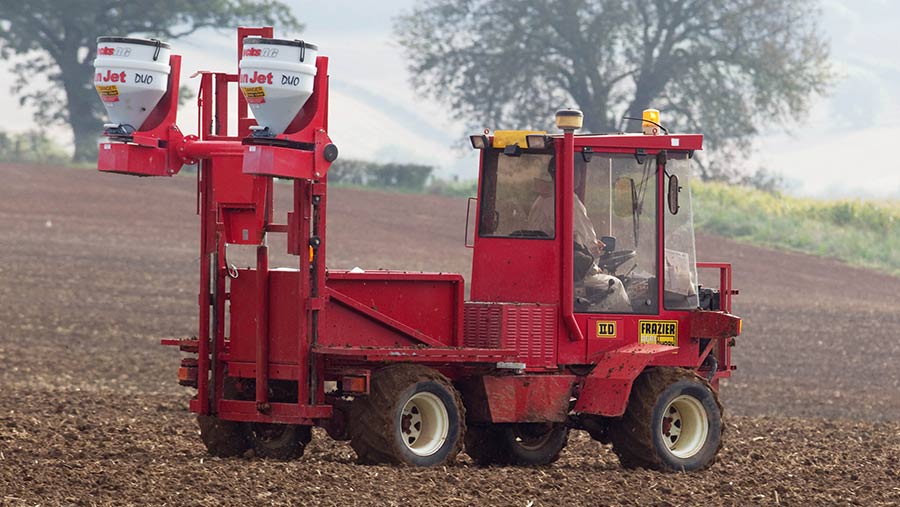Crop Watch: Rising threat from slugs and BYDV
 Slug pellet application © Tim Scrivener
Slug pellet application © Tim Scrivener While attention is still focused on trying to establish winter crops whenever there is a break in the weather, with only around 25% of crops planted in some areas, the risk of Barley Yellow Dwarf Virus and slug damage for those lucky enough to have already drilled cereals should not be overlooked.
Although the rain has reduced numbers of migrating aphids in cereals, the number recorded by ADAS carrying virus is quite high.
For slugs the use of ferric phosphate is recommended as it outperforms metaldehyde in cold and wet conditions.
See also: Top tips for high yielding late-drilled wheat crops
West: Antony Wade

Antony Wade
Hillhampton Technical Services (Herefordshire/Shropshire)
I fear autumn 2019 is going to be one of those seasons we remember along with 2001 and 2012 for the difficult establishment conditions.
In my area we have been more fortunate than others with lower amounts of rainfall in the first half of October.
Therefore, since I last wrote we have been drilling the odd field on the occasional dry day. The majority of these have been ploughed and planted.
I realise this establishment method is distinctly unfashionable, where the plough is seen as the ‘devil’s tool’ to those who practice no-till or min-till, but it has been the only way to turn over slightly drier soil to work into a seedbed.
We did have a run of drier days last week which allowed even those who would not consider using the devil’s tool to get some planting done.
For any unplanted barley there has been a focus to try to get it in before the end of October, after which it is probably unviable due to the yield drop-off as you get into November.
We have more time to establish wheat, and oats can be planted into the spring, which we did back in 2012 with little yield penalty.
Terrible damage
A common comment I have made on seedbeds is “well it’s not too bad considering” but some after maize, potatoes and in wetter fields have been forced and are less than ideal.
I’m pretty sure those cheques taken for renting out ground for potatoes and maize this season are not going to cover the soil damage that has been caused as it will take years to resurrect.
We are also fortunate in that we don’t generally have the grassweed pressure here experienced by other areas, so I totally understand colleagues in those areas that are concerned about drilling cereals and then not being able to get pre-emergence herbicides applied.
On the recently planted crops we are taking the attitude that we will have to try to deal with herbicides for grassweeds early post-emergence.
Even these plans might have to be delayed for a while after 51mm in 16 hours in the days before I write this article, with flooded fields and rivers bursting their banks this is certainly going down as a memorable one!
East: Marion Self

Marion Self
Prime Agriculture (Suffolk)
Before writing I checked the weather forecast in the vain hope that I could offer a ray of sunshine and encouragement.
At best the outlook teases a brief period of drier, cooler weather. Let’s hope this is long enough to enable drills and sprayers to run.
Meanwhile, another wet week has halted drilling and the area of cereals drilled is an estimated 25%.
Some growers have been unable to make a start yet. It’s been said before, but there is still time to complete winter wheat drilling.
Wait for decent drill conditions, stay focused on achieving a good result and remember late-drilled, mauled in wheats will not reward!
Pre-emergence
The silver lining is the colossal amount of blackgrass that has flushed and been killed before drilling.
Frustratingly, opportunities to “spray-off” stale seedbeds ahead of drilling have been few and often snatched between rains.
Indeed, last week there were some ugly occurrences as desperate operators struggled to spray-off stale seed beds and apply pre-emergence herbicides on ground that is too wet.
Planned Avadex (tri-allate) granule applications have been abandoned most often where the applicator is fixed to the rolls (no way José!) or where a separate application would cause another set of damaging wheelings.
In difficult situations, review your planned residual herbicide treatments in view of crop safety and adjust them according to the delayed drill date and seed bed conditions.
Remember post-emergence ALS inhibitors may not be as effective so pre-ems could be essential in some situations.
While desperate to put all efforts into drilling, don’t overlook Barley Yellow Dwarf Virus control on earlier emerged cereals.
Slug pressure is also high, crops should be monitored carefully for activity and treated promptly.
In catchy conditions switch to ferric phosphate-based pellets which are much more resilient in wet and cold conditions.
Rapeseed continues to be problematic; as reported here by other agronomists, small crops continue to struggle, lack of vigour means that many of these marginal crops will be abandoned before further inputs are necessary.
Carefully consider the realistic viability of struggling crops; especially before applications such as propyzamide that severely limit following crop options if the crop fails.
Early drilled crops continue to look well, although it is worth checking larvae infestation.
Some fabulous-looking crops already have significant larvae infestation in the leaf petioles and stem base. Phoma is developing steadily, fungicide treatments should be applied soon.
South: Richard Harding

Richard Harding
Procam (Sussex)
Even for an eternal optimist, the recent run of wet weather has been very testing and no establishment system has been immune to weather delays.
A few dry interludes between the showers has allowed some plough planting, but overall progress with drilling has been very sketchy, with most being achieved on the more free draining Downs.
On the plus side grassweeds continue to emerge in the wet conditions, making the priority to get fields sprayed off before the drill, ready to take advantage of any window for drilling that opens up.
The optimism continues and another positive from the current weather and declining soil temperatures is that the risk of take-all in second wheats is now subsiding.
Soil temperatures for last week were (on average) 13°C. This is still 1.5°C above what we would usually expect for the end of October.
Take-all is considered to be most active in the soil at temperatures of above 10-12°C. Ideally, drilling when soil temperatures are at or below 12°C degrees soon after germination, reduces the risk of take-all affecting early seedling growth.
This guidance is relevant irrespective of whether a take-all active seed treatment is used.

LIght leaf spot in oilseed rape © Martyn Cox
Larval invasion
Temperatures are still relatively mild and cabbage stem flea beetle adults have continued to damage some oilseed rape crops, while well established, earlier drilled crops are now starting to see larval damage in leaf petioles.
Larvae hatch after an accumulated temperature of 240°C – over a base of 3°C. So, in the temperate autumn to date, larval emergence could well be earlier than the “traditional timings” in several crops.
The downside is that with continuing adult activity, egg laying will continue, meaning larval invasion will also continue well into next spring. It is now also possible to find the first aphids in oilseed rape crops.
Although the rain has reduced numbers of migrating aphids in cereals, the number recorded by ADAS carrying virus was quite high.
However, the numbers of the bird cherry-oat aphid recorded and tested are lower than the 10-year mean for this time of year.
This year the AHDB BYDV management tool is going to prove very useful to predict the optimum insecticide timing locally.
Phoma leaf spot is beginning to appear in crops – generally at low levels to date and below threshold levels.
Although early drilled crops (before mid-to-late August) are the crops most at risk from light leaf spot, a planned fungicide will be applied in late October/early November weather permitting, as this has been shown to be an effective strategy to provide early protection.
As soil temperatures are certainly cooling as they get wetter. Thoughts may normally be turning to propyzamide applications.
While the latest Corteva propyzamide timing tool is now available. It’s probably still a bit early and just another job to add to the long list of other things to do once the soil is dry enough to travel!
North: Mary Munroe

Mary Munro
Strutt and Parker (Perthshire)
The last month has been a struggle for most arable farmers with wet weather dictating what can and cannot be achieved.
My focus is on my East Lothian neighbourhood which is drier than much of the country, and even here progress with field work has slowed to a snail’s pace.
Establishment is half the battle with crop production, and we are now dealing with all the challenges that wet weather brings – ground too wet to work, cloddy seedbeds, crops that were drilled but not rolled, autumn herbicides still to go on, slugs, and a general slowing of growth.
However, it is not too late to catch up with much of the work if the weather changes.
This means that Plans A, B and C are all still in the running and a fair degree of juggling is needed – not just for the grower, but also for the agronomist.
Slugs are a priority for the wheat crops drilled into these cooler, cloddy seedbeds, to reduce the prospect of seed being eaten before it can emerge.
It may be that some autumn herbicides do not go on. Right now, we are still looking at Plan A, but are quietly checking the options.
In some cases the grower has to sit on their hands waiting for potatoes to be lifted, and a philosophical approach is needed.
At some point though, the plan for sowing wheat may have to be abandoned, and an alternative spring crop grown instead.
Oilseed rape
Oilseed rape crops are not suffering anything like the impact of flea beetle to the extent of colleagues in the south and we have not had any write-offs.
It may be stating the obvious, but wet weather highlights the differences that soil type and management can have.
The benefits of soil organic matter are clearest in extreme conditions and those who are stuck in the farm office could arrange some soil analysis and investigate the availability of manures and composts.
Many of these manures do not last long in the soil, and ideally should become an annual input to get the best from them.

